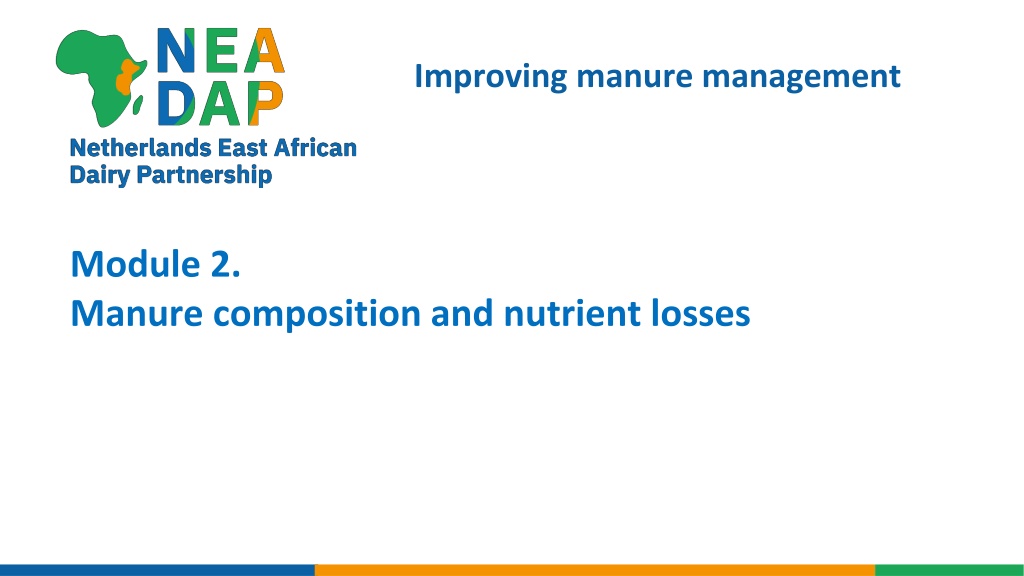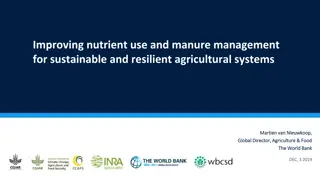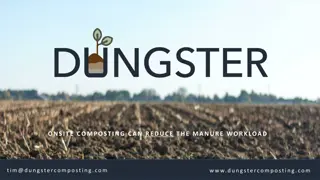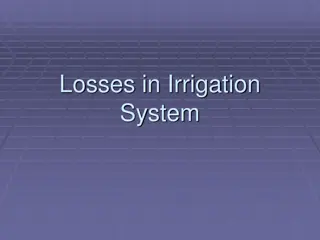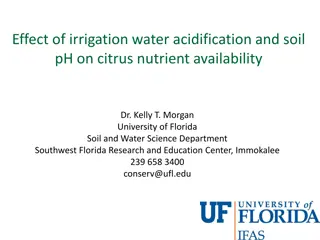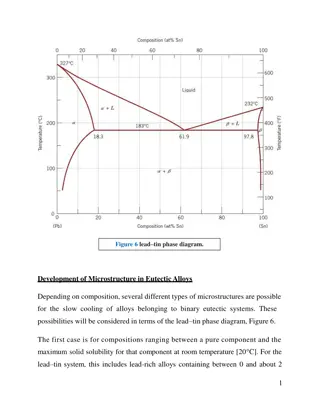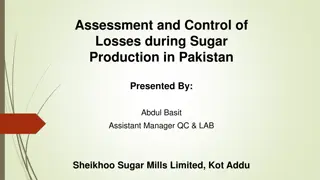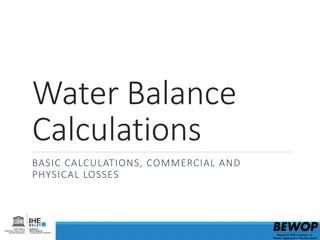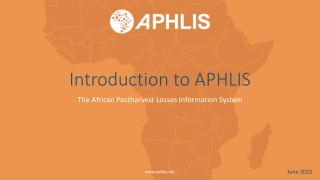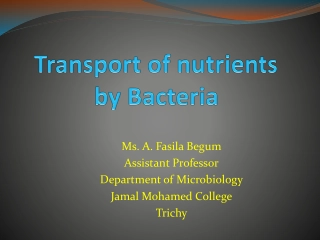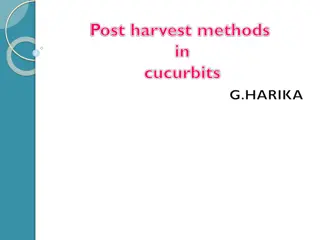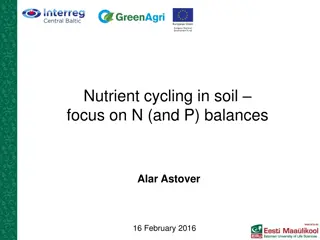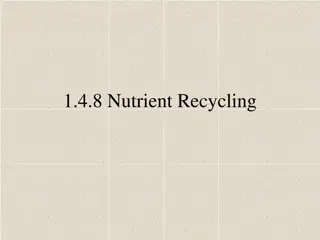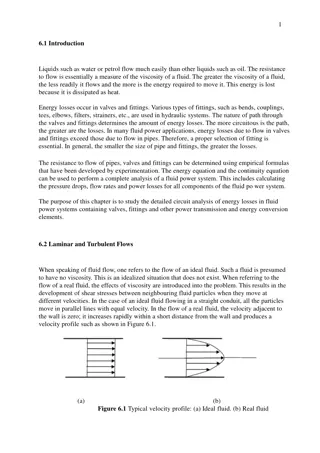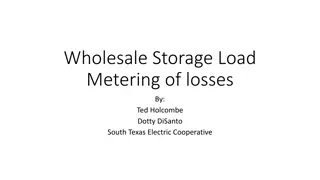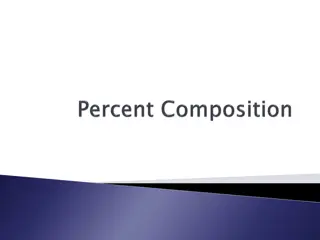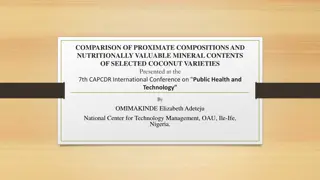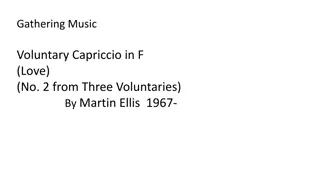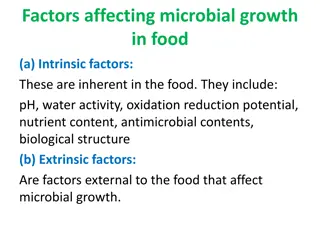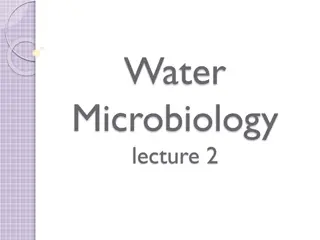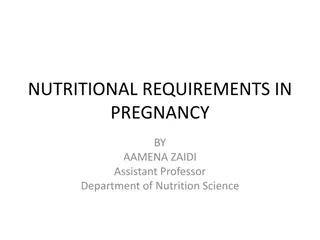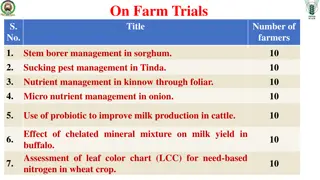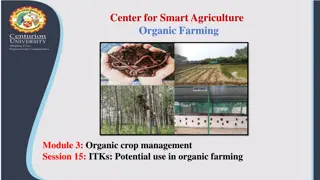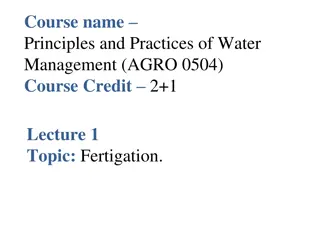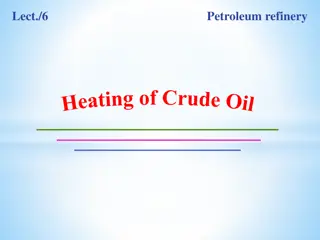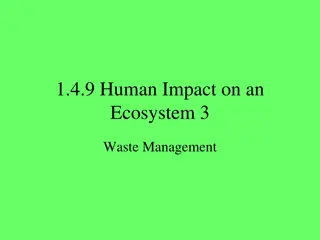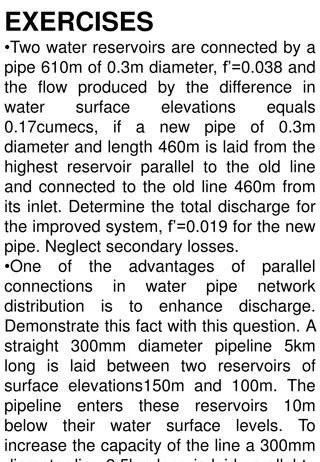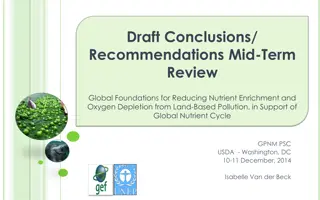Understanding Manure Management: Compositions, Nutrient Losses, and Factors
Explore the complexities of manure management by delving into manure compositions, nutrient losses, and the various factors influencing the quality and quantity of manure. Learn about the impact of animal species, diets, and management practices on manure characteristics, as well as strategies to mitigate nutrient losses through leaching, runoff, volatilization, and drainage pathways.
Download Presentation

Please find below an Image/Link to download the presentation.
The content on the website is provided AS IS for your information and personal use only. It may not be sold, licensed, or shared on other websites without obtaining consent from the author. Download presentation by click this link. If you encounter any issues during the download, it is possible that the publisher has removed the file from their server.
E N D
Presentation Transcript
Improving manure management Module 2. Manure composition and nutrient losses
Learning objectives of Module 2 1. Understand the factors affecting manure quantity and quality: Impact of animal species, diet and manure management practices on manure characteristics 2. Understand the interplay of different factors and pathways of manure nutrient losses: Main pathways of nutrient losses: Leaching, run-off, volatilization and drainage Strategies to prevent nutrient losses
Factors affecting manure quantity and quality Major factors that determine manure quantity and composition: Manure characteristics as excreted depend mainly on: animal species, bodyweight and age feeding regime The quantity and quality of the manure as stored depend mainly on: production system: grazing, confined animal housing manure management practices: collection, storage and treatment e.g. addition of water for flushing and/or organic materials, treatment such as composting
Animal species and composition of excreta Digestive system determines type and composition of excreta: ruminants and pigs: dung and urine; poultry (birds): only one type of excreta cattle digest fibrous feed: excreta contain more organic matter organic matter of cattle dung: slower breakdown than that of pigs urine from cattle contains mainly N (urea) and K; urine from pigs (monogastric animals) contains N (urea), P and K; poultry excreta contains N (uric acid), P and K.
Animal species and amount of excreta Source: E. Teenstra et al. 2015. Manure Management in the (Sub-)Tropics; Training Manual for Extension Workers Cows weighing about 250 kg to 400 kg.
Composition of cattle excreta Macro nutrients Primary nutrients: nitrogen (N) in the dung and urine phosphorus (P) in the dung potassium (K): mainly in the urine Secondary nutrients mainly in the dung: magnesium (Mg), calcium (Ca), sulfur (S) Micro nutrients or trace elements in urine and dung: Na, Cl, Cu, Zn, B, Mn, Fe, Cr, Mo, Co, Se Organic matter: many nutrients are bound in organic form
Example of composition of dairy cattle slurry Nutrient in cattle slurry Content of nutrient (%) On fresh weight basis Dry matter 12.0 Organic matter 7.7 Nitrogen (N) total 0.21 Phosphorus (P) 0.06 Potassium (K) 0.50 Calcium (Ca) 0.21 Magnesium (Mg) 0.07 * Slurry collected in a zero-grazing unit with concrete floor and stored for short time in closed concrete pit * Dairy cows fed with Napier grass and concentrates (1988-1989); Source: Snijders et al., 1992
Amount and composition of cattle excreta Feeding regime affects amount and composition of cattle excreta: Amount and composition of urine depend (among others) on: intake of water and feed (N and K among others), temperature (evaporation) Nitrogen levels depend on intake of protein: high levels in ration relatively high levels in urine and dung Phosphorus in dung and potassium in urine vary with levels in the feeds Quality of organic matter in dung (carbon/nitrogen [C/N] ratio) varies with the digestibility of the ration/fodder
Nitrogen in cattle excreta (1) Type of nitrogen in faeces and urine is different: N in urine: mainly present as urea (N-mineral) N in faeces: mainly present in organic compounds (N-organic) Total excretion of nitrogen (but also other nutrients like phosphorus) increases with feeding/production level Excretion of nitrogen in urine and dung varies with protein intake: the higher the protein intake, the higher the excretion
Nitrogen in cattle excreta (2) Faeces: N bound to complex organic compounds (N-organic): Nitrogen in organic form (N-org): breakdown by micro-organisms to mineral N (nitrate) before available for plant growth N-organic differs in quality depending on quality of feed: amount and quality (digestibility) of the fibres in the feed Breakdown of N-organic depends on quality N-org and climatic conditions (temperate, moisture): In temperate areas: on average 35% of N-org becomes available for crops in first year after application
Nitrogen in cattle excreta (3) Urine: N in the form of urea (N-mineral): The amount of N in urine depends on feeding/production level Urea from urine in contact with dung (in cattle slurry) is easily converted into ammonia by bacteria: high temperature increases the conversion Ammonium is susceptible to volatilization to the air when in contact with air: loss of N mineral can be very large Ammonium in contact with soil is converted by bacteria into nitrate
Effect of feeding/production level on nitrogen excretion by a dairy cow (based on Snijders et al., 1992) Dairy cow Body weight: 350 kg Milk: 3 kg per day Dairy cow Body weight: 450 kg Milk: 8 kg/day Dairy cow Body weight: 550 kg Milk: 20 kg/day Slurry production/cow/day 35 kg 45 61 Total N excretion/cow/day 96 gr/day (=100 %) 141 gr/day (=100) 233 gr/day (=100%) N excretion in urine/cow/day 43 gr/day (=45%) 64 gr/day (= 45%) 116 g/day (=50%) Total N excretion/cow/year 35 kg 51 kg 85 kg C/N ratio of dung (estimate) 41 37 26
Why so much emphasis on nitrogen in manure? Nitrogen is a key element for plant growth: enhancing production and product quality The effect of nitrogen is the most visible to the farmer: green colour, growth of crop Nitrogen in manure can easily be lost (leaching, volatilization, run-off) Nitrogen can cause pollution of ground and surface water when stocked at one place or through overfertilization of land Nitrogen is a key element of most synthetic fertilizers However, manure contains more than only nitrogen!
Benefits of other nutrients in cattle manure Phosphorus/phosphate (P/P2O5) Most African soils are deficient in phosphate Lack of phosphate affects root growth of crops Phosphate in manure is readily available for crop growth On acid soils: phosphate from manure is more available for crops than phosphate from synthetic fertilizer Potassium (K/K20): K is a key element for growth of crops like forage, bananas, coffee K is often deficient in sandy soils; often sufficiently available on clay soils Calcium (Ca): Calcium has a neutralising effect on acid soils
Benefits of organic matter in cattle manure Organic matter of manure improves soil quality by: Providing nutrients for plant growth: slow release of macro and micro nutrients Improving soil fertility: builds up the nutrient base of the soil Improving soil life: provides food for micro-organisms Improving the water-holding capacity of the soil Improving the soil structure Reducing soil acidity
Run-off and drainage of manure nutrients into soil Run-off and/or drainage of manure nutrients will occur if: Manure is discharged directly to public areas, water streams (losses can be extensive) Poor storage of manure heaps or piles: not protected during heavy rainfall or put on sloping land Manure flows in trenches to the land combined with heavy rainfall Applying manure in (too) large amounts superficially on land combined with heavy rainfall
Potential nutrient losses from manure Run-off/drainage: N, P, K, other minerals and organic matter Volatilization: N: ammonia and nitric acid C: methane Leaching/drainage to ground water: N: nitrate at spots with large manure loads or overfertilization of land P: excessive manure loads can lead to phosphate saturation of soils K and other water-soluble minerals: excessive manure loads, over fertilization of land
Strategies to reduce run-off/drainage losses Use proper (closed) collection and storage system. Use a cover to protect manure heaps/piles from rain. Avoid overfertilization of land.
Volatilization of manure nutrients and prevention (1) Volatilization of nitrogen (N) in the form of ammonia Ammonia is converted from urea and uric acid by bacteria when urine comes in contact with dung or soil Volatilization of ammonia occurs in animal housing, manure storage, during application of manure onto land Losses of N can be extensive (30 70% of total nitrogen) in cattle slurry
Volatilization of manure nutrients and prevention (2) Volatilization of nitrogen in the form of nitrous oxide (N2O) and methane (CH3) Nitrous oxide and methane: conversion of mineral N under anaerobic conditions Both gasses are volatile and contribute to GHG emissions (climate change) Nitrous oxide is a product of the denitrification process of nitrate Nitrous oxide and methane can volatilize from manure storage (anaerobic pockets) and after application on land (wet conditions)
Strategies to reduce volatilization losses by ammonia N Separate collection and storage of urine and faeces in the barn Concrete the floors of walking areas in zero-grazing units with cubicles Roof the walking areas of a zero-grazing unit Frequently remove of dung and urine (slurry) into a closed storage pit Mix cattle slurry with soil at time of application Apply slurry on land/crops when rain is expected
Strategies to reduce volatilization losses by N2O and methane Prevent overly long and anaerobic storage of manure Avoid application on overly wet land
Overview of nitrogen losses from manure If not incorporated Run-off Nitrate is water soluble; it can move downwards through the soil profile to groundwater
Leaching of manure nutrients and prevention Leaching of manure nutrients: Water-soluble nutrients like N and K can leach to deeper soil layers and/or groundwater Leaching can happen on spots with excessive manure loads (manure storage on open land) or overfertilization of land Leaching of manure nutrients can lead to contamination of drinking water (nitrate, phosphates) taken from wells Leaching of P to groundwater can happen on P-saturated soils Strategies to reduce leaching losses: Use of good (closed) collection and storage system Prevent overfertilization: application of manure on land according to crop needs
Effect of poor manure management on water quality Improper application Improper manure piling Improper manure storage Run-off Run-off Run-off O O M M P P N N Surface water Leaching Leaching N N N N Nitrate Nitrate Underground water
Summary The quantity and value of cattle manure for crop production will depend on: the composition of the excreta (feeding/production level) the production and housing system (confinement, collection system, use of bedding materials) the management of the manure from collection until application nutrient losses due to manure management (collection, storage, treatment and application) Major nutrient losses can occur in the form of volatilization, run-off and drainage and leaching but can be reduced by better management practices.
